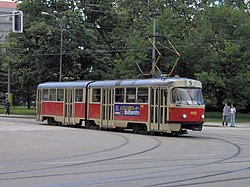Tatra K2
| Tatra K2 | |
|---|---|
 K2 tram in Brno | |
| Manufacturer | ČKD Tatra |
| Constructed | 1966–83 |
| Successor | Tatra K5AR |
| Capacity | 49 (Seated) 108 (Standing) |
| Specifications | |
| Train length | 21,600 mm (70 ft 10 in) |
| Width | 2,500 mm (8 ft 2 in) |
| Height | 3,050 mm (10 ft 0 in) |
| Low-floor | 0% |
| Doors | 4 |
| Articulated sections | 1 |
| Track gauge | 1,435 mm (4 ft 8+1⁄2 in), 1,000 mm (3 ft 3+3⁄8 in), 1,524 mm (5 ft) |
The Tatra K2 was the first production articulated tramcar built by ČKD Tatra between 1966 and 1983, following the failure of the experimental K1 which never entered production. It was noted that the main problem with the K1 was with the new electrical equipment, and therefore the same electrical equipment of the T3 was incorporated into the new K2. The prototype entered service in 1966 as Prague tramcar number 7000, where it spent only a short spell before being transferred to Most, and then again moved to Brno. Production of the K2 on a mass scale started the same year, and many examples remain in service to this day,[when?] albeit most having been extensively modernised. The modernisation of the K2 fleet in Brno, the biggest customer of the type, included the complete re-modelling of the front end, and the upgrading of their electronic equipment. These modernised examples were labeled K2R, whereby the 'R' stands for 'reconstructed'.
Variations
K2SU
The K2SU was the version of the K2 which went on sale in Russia, also in 1966. Production of the type ended prematurely in 1969 as the vehicles were not well suited to the comparatively heavy traffic in Russian cities. Nevertheless, a total of 246 of the type entered service. The only K2SU to remain in active service was in Yekaterinburg where it was retained as an historic vehicle until 1998.
K2YU
Sarajevo was the only city in the former Yugoslavia to receive the K2, where it was labeled the K2YU. The only differences with the original K2 were in very minor details. There were also sold 15 K2YU trams to Brno and 3 to Bratislava.
Production
A total of 567 units entered service in the following cities:[1]
| City | Year | K2 | K2SU | K2YU | Total | |
|---|---|---|---|---|---|---|
| Bratislava | 1969–83 | 86 | - | 3 | 89 | |
| Brno | 1967–83 | 117 | - | 15 | 132 | |
| Kharkiv | 1968–69 | - | 35 | - | 35 | |
| Moscow | 1967–69 | - | 60 | - | 60 | |
| Novosibirsk | 1966–69 | - | 36 | - | 36 | |
| Ostrava | 1966–83 | 10 | - | - | 10 | |
| Rostov-on-Don | 1968 | - | 5 | - | 5 | |
| Samara | 1967–69 | - | 35 | - | 35 | |
| Sarajevo | 1973–83 | - | - | 90 | 90 | |
| Tula | 1968–69 | - | 20 | - | 20 | |
| Ufa | 1968–69 | - | 35 | - | 35 | |
| Yekaterinburg | 1967–69 | - | 20 | - | 20 | |
| Total | 213 | 246 | 108 | 567 |
Photo gallery
- Tatra K2
-
Modernized trams type K2S in Bratislava
-
K2 tram in Brno
-
K2R tram in Ostrava
-
K2YU tram in Sarajevo
-
Sarajevo K2 renovated by Inekon Trams
References
- ^ "Tatra K2 production list". Strassenbahnen-Online. Retrieved 2007-12-10.





